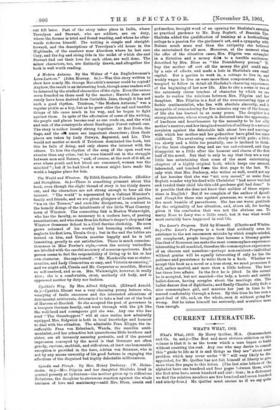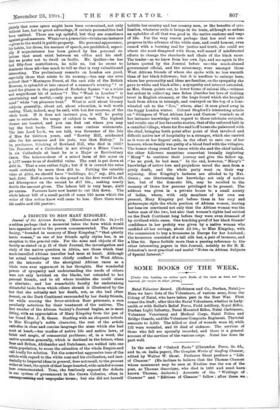CURRENT LITERATURE.
WHAT'S WHAT, 1002.
What's What, 1902. By Harry Quilter, M.A. (Sonnenschein and Co. 6s. net.)—The first and most obvious criticism on this volume is that it is as the tower which a man began to build without counting the cost. Any one who may desire to consult this "guide to life as it is and things as they are" about some problem which may occur under " W " will very likely be dis- appointed, for Mr. Quilter has not felt himself at liberty to give more than five pages to this letter. (The last nine letters of the alphabet have one hundred and four pages between them, while the first nine have seven hundred and sixty-four; in a dictionary we find the relative numbers are five hundred and seven hundred and ninety-four.) Mr. Quilter must excuse us if we say quite plainly that some space might have been economised, not only without loss, but to great advantage, if certain personalities had been omitted. These are nqt spiteful, but they are sometimes aseinst good manners. Whatever a journal ist—to take one instance 'yes to the world is public property. His personal appearance, his habits, his dress, his manner of speech, are prohibited, especi- ally if acquaintance has been gained by the personal re- lations that must exist between an editot and his staff. But we prefer not to dwell on faults. Mr. Quilter—he has had fifty-four contributors, he tells us, but he seems to dominate them all—has much to tell us that is very valuable and interesting. The preliminary remarks on London are good, especially those that relate to its scenery,—has any one ever ncticed that "Montague Street, at the east side of the British Museum, is splendid at late sunset of a summer's evening " ? or noted the planes in the gardens of Berkeley Square "as a triste and magnificent bit of nature" The "Week in London ' is entertaining and useful,—only you must not "have a frugal mind" while "on pleasure bent." What is said about literary subjects generally, about art, about education, is well worth reading. That, indeed, may be said, with but few reserves, of the whole book. If it does not instruct you, it will be pretty sure to entertain. Its range of subject is vast. The highest themes are treated, and you can find out where you may buy the best boots. There are some curious statements. The late Lord Loch, we are told, was Governor of the Isle of Man for thirteen years, and "Rowley Hill, celebrated alike for his sermons and his jests, was then Bishop." Is he, perchance, tIduking of Rowland Hill, who died in 1833? The Precentor of a Cathedral is not always a Minor Canon. In six Cathedrals at least he is a Major or Residentiary Canon. The balance-sheet of a mixed farm of 500 acres on p. 1,177 seems to us of doubtful value. The rent is put down at £156 5s. That s, ems rather high ; but if it is correct the rates would certainly be more than £13 5s. Putting the rateable value at 1314, we should have "buildings, &c.," say, £64, and land, £280. Half-a-crown in the pound on the first would be £8, and fifteenpence on the second be £17 10s., making nearly double the amount given. The labour bill is very large, 1468 per annum. Fanners have now learnt to cut this down. The whole labour bill of a small parish of some 950 acres which the writer of this notice knew well came to less. Here there were 325 arable and 625 pasture.











































 Previous page
Previous page